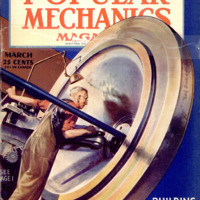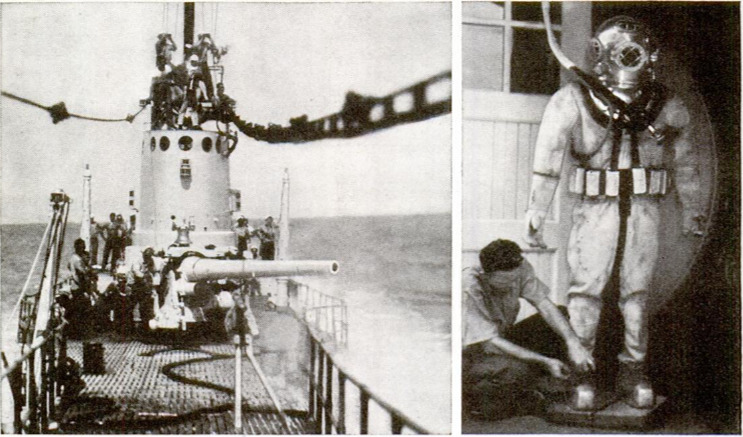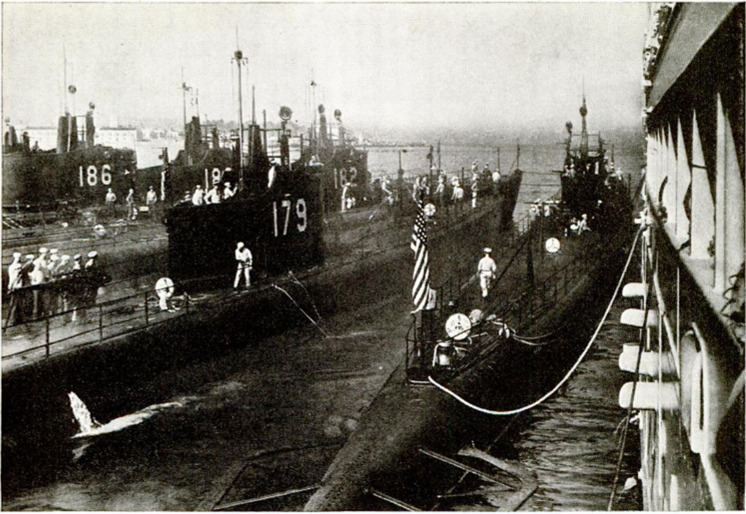IT TAKES iron men to operate the steel fish which comprise the submarine fleet. Just now, with the nation’s shipyards turning out underwater craft at a new high rate, the critical problem is to find super-sailors for the subs. Many are being trained ata remarkable school which the navy operates at the submarine base near New London, Conn., on the Thames River. Huge as it is, with baitding after building giving the appearance of a large league university, the school has done well up to now to turn out two or three new submarine crews a month, so fine do its mills of knowledge grind. Before a man can be considered for sub service, he must have passed rigid navy recruiting tests, entered the service, served long enough to get a fine record, and then must have made up his mind that the extra hazards and discomforts which naturally go with undersea fighting are especially attractive to him. “Be reliable” is the slogan of the training station and signs bearing these words are scattered throughout the buildings. But the secret of the success of its graduates at their chosen careers is that it is not enough for a man to be reliable at one submarine job. He must be reliable at two tasks at least, so that one crew of 40 men is the equal of 80 or more. A gunner, for example, might double as a quartermaster and he must be perfect in both jobs. But, for this double reliability and double competence, Uncle Sam pays extra salary and many a sailor, not interested in the long grind which it takes to become a chief petty officer on a surface ship, swings into the exciting submarine branch. That is, he swings to the submarine branch if he has already demonstrated in the navy that he is the type who can be depended upon in a pinch. Presuming that he has passed the navy examinations, served efficiently, shown his dependability and is finally accepted as a candidate for the submarine school, one day he packs his bag and travels to New London. The first thing he finds here is that all of his physical tests, which permitted him to enter the navy, count for nothing. A corps of physicians pound and thump, prod and poke, seeking a physical defect which may cause human failure at a critical moment aboard a submarine. If these doctors can find nothing the matter with him, the supreme test comes - the compression chamber. When they finish this test, five out of every hundred candidates pack their bags and go back to the surface ships where they belong. They have everything it takes, perhaps, except the ability to stand pressure which always builds up when a steel fish slides below the surface of the sea. It seems that because of one ailment or another, sometimes so trivial as to escape notice, the tubes which run through the bones of the head become clogged or closed. When air at a pressure of 50 pounds enters one of these tubes and is suddenly blocked, the pain which builds up is excruciating and the compression chamber test discovers whether this condition exists. Half a dozen men, more or less, are placed in the chamber. Steel doors clank shut, making it airtight. Then compressed air is gradually fed into the chamber. The men are told to raise a hand if they feel pain, or have trouble in standing the pressure. Most of them stand it quite well. Occasionally a sailor will raise a hand, indicating pain. He will be told to blow his nose lustily. This often clears the tubes. Or he will be shown how to grind his jaws sideways, which may relieve his discomfort. But once in a while none of these standbys helps and the candidate will turn pale with pain, often scream with agony. A signal is given, the pressure is dropped, he is led out of the chamber - and that is the end of the submarine service for him. Another interesting test is given in a water-filled steel tower at the base. The candidate, wearing artificial lungs with attachments clamped over his face, is led into a lock, or airtight chamber at the bottom of the tower. The chamber’s outer door is closed and, at a signal, the inner door is opened. Water rushes in and when the chamber is filled, the sailor is supposed to shove out calmly and rise to the surface of the water at the top of the tower. Most of the men have no trouble if they have passed the compression chamber test. Occasionally, however, a sailor will scream with fright, or tear off the mask and come to the top of the water gasping and choking. He simply could not stand the sensation of being cut off from the outer air. He might make a brilliant and daring aviator, but he will never qualify as an iron man for a steel fish. So it is back to general navy service for him. In fact, the whole three months or more that a man spends in the submarine school is a test, for he is continually under observation by his instructors, who are usually veteran submarine sailors, and they are quick to spot any sign that a man is not fit for his responsibilities under the ocean’s waves. Is he flighty, or easily rattled? This is probably the final and capping test and it often comes when the candidate makes his first real dive in a submarine. Then he takes his post and handles routine orders. Perhaps he does well. Pandemonium will break loose, however, at the order of the commander. A diving order will be given. A fire alarm will also be sounded. Under each of these circumstances, every doubleduty submarine sailor has one or more tasks to perform quickly and calmly. If the candidate does the wrong thing first, or the right thing too late or gets hopelessly confused, he’s a marked man. He gets another chance, of course. But he will have to prove himself beyond doubt before Uncle Sam will trust him with the lives of his fellow crew members. If he measures up physically and temperamentally, he has a number of basic lines between which he can choose - radio, sound operations, battery work, gyro operations or Diesel work - and he is sure to come out of the training competent in at least two specialties. As radio man he is likely to become also an expert in sound detection. As a battery man, learning to care for the 120 cells in each battery, each cell weighing nearly a ton, he may also be trained in gyro work and operation of the sub’s controls. As Diesel man, working on the huge motors which drive a sub when it is on surface, he is sure to have another line in which he can double when the ship is below surface and the Diesels are shut off in favor of battery power. To learn all of these things the classrooms include what is practically one or more large submarines taken apart and installed in the buildings. Huge Diesels are housed in a separate structure and there the sailors learn not only to run a Diesel almost as big as a cottage, but to take it apart and put it back together. Substituting for the actual submarine for early training in manipulating the controls is a hooded platform which tilts up and down in response to submarine controls like a regular ship. While a petty officer gives quiet orders, the sailors are taught to submerge and resurface, In another building which looks something like a florist’s hothouse, are rows of great batteries and, like gardeners tending their plants, the future sub men pass along row by row watering and tending the cells. Even the intricate electric controls are transplanted into the building and here, as the orders are flashed in front of the novice he learns to trim ship and control speed. A small number of lucky ones are given training in diving and this becomes one of their specialties when underwater repairs are needed on submarines. Thus before they set foot on a real submarine, the sailors become thoroughly familiar with every part of a submersible in the various rooms of the school.
 Popular Mechanics, vol. 77, n. 3, 1942
Popular Mechanics, vol. 77, n. 3, 1942





